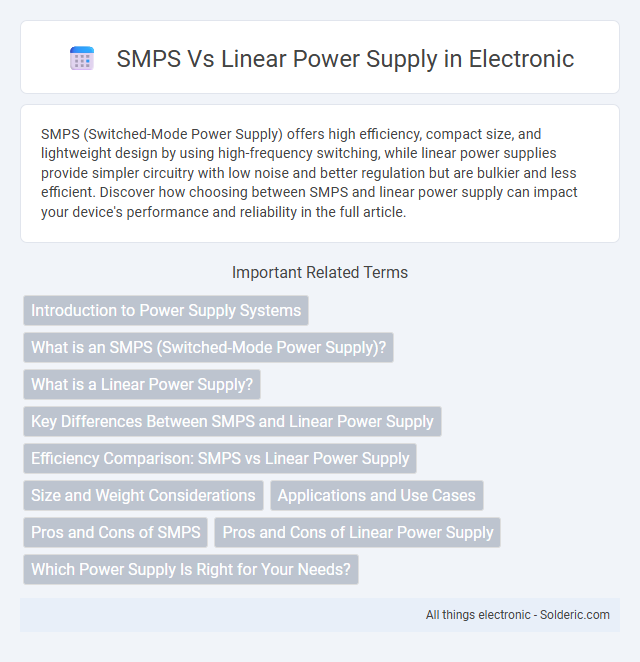SMPS (Switched-Mode Power Supply) offers high efficiency, compact size, and lightweight design by using high-frequency switching, while linear power supplies provide simpler circuitry with low noise and better regulation but are bulkier and less efficient. Discover how choosing between SMPS and linear power supply can impact your device's performance and reliability in the full article.
Comparison Table
| Feature | SMPS (Switched-Mode Power Supply) | Linear Power Supply |
|---|---|---|
| Efficiency | High (80-90%) | Low (40-60%) |
| Size & Weight | Compact and Lightweight | Bulky and Heavy |
| Heat Dissipation | Low Heat Generation | High Heat Generation |
| Output Noise | Higher Ripple and Noise | Low Ripple and Noise |
| Complexity | Complex Circuitry | Simple Circuit Design |
| Cost | Moderate to High | Low to Moderate |
| Voltage Regulation | Excellent Under Varying Loads | Stable but Less Efficient |
| Applications | Computers, LED Drivers, Industrial Devices | Audio Equipment, Lab Devices, Low Noise Systems |
Introduction to Power Supply Systems
Switch Mode Power Supplies (SMPS) utilize high-frequency switching regulators to convert electrical power efficiently, resulting in compact size and reduced heat generation compared to linear power supplies. Linear power supplies rely on transformer-based voltage conversion and continuous linear regulation, producing less electrical noise but less efficiency and larger physical dimensions. In power supply systems, the choice between SMPS and linear technology impacts energy efficiency, thermal management, cost-effectiveness, and electromagnetic interference in electronic devices.
What is an SMPS (Switched-Mode Power Supply)?
An SMPS (Switched-Mode Power Supply) is an electronic power supply that uses switching regulators to efficiently convert electrical power. It rapidly switches on and off to regulate voltage and current, resulting in higher efficiency and reduced heat generation compared to linear power supplies. SMPS units are widely used in computers, industrial equipment, and consumer electronics due to their compact size and energy-saving capabilities.
What is a Linear Power Supply?
A linear power supply converts AC voltage to a lower DC voltage using a transformer, rectifier, and voltage regulator, providing clean and stable output with minimal noise. Unlike SMPS (Switched-Mode Power Supply), it operates by dissipating excess voltage as heat, resulting in lower efficiency but superior voltage regulation. Your choice of a linear power supply suits applications requiring low electromagnetic interference and precise voltage control.
Key Differences Between SMPS and Linear Power Supply
Switching Mode Power Supplies (SMPS) differ from linear power supplies primarily in efficiency, size, and heat generation. SMPS convert power using high-frequency switching components, resulting in higher efficiency and compact design, whereas linear power supplies regulate voltage through dissipative components, causing more heat and larger form factors. Your choice between SMPS and linear power supplies depends on requirements like power efficiency, noise sensitivity, and physical space constraints.
Efficiency Comparison: SMPS vs Linear Power Supply
Switch Mode Power Supplies (SMPS) typically achieve efficiency rates between 80% and 90%, significantly higher than the 40% to 60% efficiency of Linear Power Supplies. SMPS convert electrical power using high-frequency switching and energy storage components, minimizing energy loss as heat. In contrast, Linear Power Supplies regulate voltage through dissipative components, leading to greater energy loss and heat generation.
Size and Weight Considerations
SMPS (Switched-Mode Power Supply) offers significant advantages over linear power supplies in size and weight due to its high-frequency operation, which allows for smaller transformers and components. Your choice of SMPS results in a compact and lightweight design ideal for modern electronics with space constraints. Linear power supplies are bulkier and heavier because they rely on large transformers and heat sinks for voltage regulation.
Applications and Use Cases
SMPS (Switched-Mode Power Supply) is widely used in applications requiring high efficiency and compact size, such as computers, telecommunications equipment, and LED lighting systems. Linear power supplies find their niche in audio equipment, laboratory instruments, and low-noise applications where voltage stability and minimal ripple are critical. Both types serve distinct roles depending on power quality, size constraints, and electromagnetic interference considerations.
Pros and Cons of SMPS
SMPS (Switched-Mode Power Supply) offers high efficiency, smaller size, and lighter weight compared to linear power supplies, making it ideal for compact and portable electronic devices. However, SMPS can generate electromagnetic interference (EMI) and produce more electrical noise, which may affect sensitive audio or radio-frequency applications. Your choice depends on whether efficiency and space-saving outweigh the need for cleaner, noise-free power delivery.
Pros and Cons of Linear Power Supply
Linear power supplies offer stable and low-noise output, making them ideal for sensitive audio or laboratory equipment. Their simple design ensures reliability and minimal electromagnetic interference but results in lower efficiency and higher heat dissipation compared to SMPS. You should consider their larger size and heavier weight when space or portability is a concern.
Which Power Supply Is Right for Your Needs?
Switching Mode Power Supplies (SMPS) offer higher efficiency, compact size, and better heat dissipation, making them ideal for modern electronics and applications requiring lightweight solutions and energy savings. Linear power supplies provide cleaner, low-noise output voltage, which is crucial for sensitive audio and laboratory equipment where minimal electrical interference is essential. Choosing the right power supply depends on balancing efficiency, noise tolerance, size constraints, and specific application requirements.
SMPS vs linear power supply Infographic

 solderic.com
solderic.com